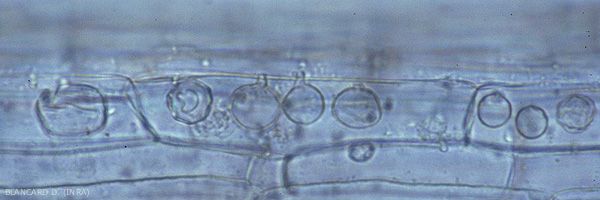
Olpidium brassicae
(Woronin) PA Dang (1886)
or
Olpidium virulentus (Sahtiy) Karling
Structures produced by Olpidium spp. These obligate parasitic fungi find in soilless cultures conditions entirely favorable to their development in the cells of the cortex. Until now it was thought to be dealing with the species Olpidium brassicae . It could in fact be Olpidium virulentus, which is a "non-cruciferous" strain of the species Olpidium brassicae sensu lato and which has been renamed following recent biological and molecular analyzes carried out in several species of Olpidium . Let us recall that this species is particularly feared in lettuce as a virus vector: the ( lettuce large vein virus Mirafiori lettuce big vein virus , MLBBV ) and probably the agent of the necrotic rings of lettuce ( Lettuce ring necrosis agent , LRNA ).
Note that the information contained in this sheet comes from the bibliography on the species Olpidium brassicae before molecular methods make it possible to differentiate them from others within the same taxon.
- Symptoms
The presence of O. brassicae in the roots can easily be confirmed by observing the latter under a microscope. This fungus, an obligate aquatic parasite , forms resting spores (or "chlamydospores") and sporangia in the cells of the cortex, which are the source of numerous zoospores.
The more or less decomposed roots of soilless crops are often invaded. In this case, it is very difficult to establish its role: parasite of weakness or simple secondary opportunist.
- Elements of biology
O. brassicae is characterized by the presence of zoosporangia filling the root cells of the cortex, and resting star-shaped spores (Figure 1).
 |
| Figure 1 |
The chlamydospores that O. brassicae product ensure its preservation for many years in the soil and on plant debris. It can also be maintained on several intermediate hosts given its polyphagia, in particular several market garden species: salads, cucumber It can very well be perennial in irrigation circuits, nutrient solution tanks and substrates.
The contaminations occur through zoospores uniflagellate from spores or resting sporangia. They are attracted to the roots, become encysted on their surface, then enter directly into the cells. The fungus produces one or more aggregated sporangia there which will generate zoospores ensuring secondary contamination.
Zoospores are released outside the root cells through release tubes. Once in the water phase of the soil or in the nutrient solution, a flagellum allows them to move and reach other plants. O. brassicae is certainly also disseminated by soil dust, contaminated plants and circulating water.
This fungus is perfectly adapted to aquatic life and it quickly spreads in hydroponics. It grows well at temperatures between 10 and 16 ° C .
- Protection
The fight against this soil fungus is not justified in the context of tomato production.
However, special care should be taken with the quality of the water used, especially in above-ground cultivation. Indeed, the latter may be the cause of contamination of Pythiaceae, Colletotrichum coccodes and Fusarium oxysporum f. sp. radicis-lycopersici .





